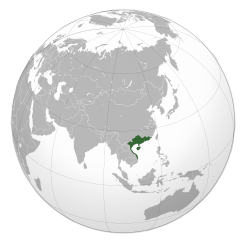
Back Nan-Yue ALS نانياو Arabic Nanyue AST Dinastiyang Triệu BCL Nanyue Catalan Nàng-uŏk-guók CDO Nan-jüe Czech Nanyue Danish Nan-Yue German Βασίλειο των Νανγιούε Greek
Nanyue | |||||||||||||
|---|---|---|---|---|---|---|---|---|---|---|---|---|---|
| 204 BC–111 BC | |||||||||||||
Seal of Emperor Wen
| |||||||||||||
 Location of Nanyue at its greatest extent | |||||||||||||
| Capital | Panyu | ||||||||||||
| Common languages | Old Chinese Baiyue languages | ||||||||||||
| Ethnic groups | Chinese (Huaxia people) Baiyue Peoples | ||||||||||||
| Religion | Chinese folk religion local Shamanism | ||||||||||||
| Government | Monarchy | ||||||||||||
| Emperor or King | |||||||||||||
• 204–137 BC | Zhao Tuo | ||||||||||||
• 137–122 BC | Zhao Hu | ||||||||||||
• 122–113 BC | Zhao Yingqi | ||||||||||||
• 113–112 BC | Zhao Xing | ||||||||||||
• 112–111 BC | Zhao Jiande | ||||||||||||
| Prime Minister | |||||||||||||
• 130–111 BC | Lü Jia | ||||||||||||
| History | |||||||||||||
• Qin "War of Pacification" | 218 BC | ||||||||||||
• Establishment | 204 BC | ||||||||||||
• First tribute to Han dynasty | 196 BC | ||||||||||||
• Zhao Tuo accession | 183 BC | ||||||||||||
• Conquest of Âu Lạc | 179 BC | ||||||||||||
• Second tribute to Han dynasty | 179 BC | ||||||||||||
| 111 BC | |||||||||||||
| Population | |||||||||||||
• 111 BC | 1,302,805 | ||||||||||||
| Currency | Ban Liang | ||||||||||||
| |||||||||||||
| Today part of | China Vietnam | ||||||||||||
| Nanyue | |||||||||||||||||||||||||||||||||||
|---|---|---|---|---|---|---|---|---|---|---|---|---|---|---|---|---|---|---|---|---|---|---|---|---|---|---|---|---|---|---|---|---|---|---|---|
| Chinese name | |||||||||||||||||||||||||||||||||||
| Chinese | 南越 | ||||||||||||||||||||||||||||||||||
| Hanyu Pinyin | Nányuè | ||||||||||||||||||||||||||||||||||
| Jyutping | Naam4 Jyut6 | ||||||||||||||||||||||||||||||||||
| Literal meaning | "Southern Yue" | ||||||||||||||||||||||||||||||||||
| |||||||||||||||||||||||||||||||||||
| Vietnamese name | |||||||||||||||||||||||||||||||||||
| Vietnamese alphabet | Nam Việt | ||||||||||||||||||||||||||||||||||
| Chữ Hán | 南越 | ||||||||||||||||||||||||||||||||||
| Zhuang name | |||||||||||||||||||||||||||||||||||
| Zhuang | Namz Yied | ||||||||||||||||||||||||||||||||||
Nanyue (Chinese: 南越[1] or 南粵[2]; pinyin: Nányuè; Jyutping: Naam4 Jyut6; lit. 'Southern Yue', Vietnamese: Nam Việt, Zhuang: Namz Yied),[3] was an ancient kingdom founded in 204 BC by the Chinese general Zhao Tuo, whose family (known in Vietnamese as the Triệu dynasty) continued to rule until 111 BC.[4][5] Nanyue's geographical expanse covered the modern Chinese subdivisions of Guangdong,[6] Guangxi,[6] Hainan,[7] Hong Kong,[7] Macau,[7] southern Fujian[8] and central to northern Vietnam.[6] Zhao Tuo, then Commander of Nanhai Commandery of the Qin dynasty, established Nanyue in 204 BC after the collapse of the Qin dynasty. At first, it consisted of the commanderies of Nanhai, Guilin, and Xiang.
Nanyue and its rulers had an adversarial relationship with the Han dynasty, which referred to Nanyue as a vassal state while in practice it was autonomous. Nanyue rulers sometimes paid symbolic obeisance to the Han dynasty but referred to themselves as emperor. In 113 BC, fourth-generation leader Zhao Xing sought to have Nanyue formally included as part of the Han Empire. His prime minister Lü Jia objected vehemently and subsequently killed Zhao Xing, installing his elder brother Zhao Jiande on the throne and forcing a confrontation with the Han dynasty. The next year, Emperor Wu of Han sent 100,000 troops to war against Nanyue. By the year's end, the army had destroyed Nanyue and established Han rule. The dynastic state lasted 93 years and had five generations of monarchs.
The existence of Nanyue allowed the Lingnan region to avoid the chaos and hardship surrounding the collapse of the Qin dynasty experienced by the northern, predominantly Han Chinese regions. The kingdom was founded by leaders originally from the Central Plain of China and were all of Han Chinese in origin.[5] They were responsible for bringing Chinese-style bureaucracy and handicraft techniques to inhabitants of southern regions, as well as knowledge of the Chinese language and writing system. Nanyue rulers promoted a policy of "Harmonizing and Gathering the Hundred Yue tribes" (Chinese: 和集百越), and encouraged ethnic Han to immigrate from the Yellow River region to the south. Nanyue rulers were then not against the assimilation of Yue and Han cultures.[9]
In Vietnam, the rulers of Nanyue are referred to as the Triệu dynasty. The name "Vietnam" (Việt Nam) is derived and reversed from Nam Việt, the Vietnamese pronunciation of Nanyue.[10] In traditional Vietnamese historiography, important works such as the Đại Việt sử ký considered Nanyue to be a legitimate state of Vietnam and the official starting point of their history. However, starting in the 18th century, the view that Nanyue was not a legitimate Vietnamese state and Zhao Tuo was a foreign invader started gaining traction. After World War II, this became the mainstream view among Vietnamese historians in North Vietnam and after Vietnam was reunified, it became the official state orthodoxy promoted by the ruling Vietnamese Communist Party. Nanyue was removed from the national history while Zhao Tuo was established as a foreign invader.[11]
- ^ 司马迁 (1959). 史記·南越列传(卷113). 北京: 中华书局. pp. 2967–2977.
- ^ 班固 (1962). 漢書·西南夷两粤朝鲜传(卷95). 北京: 中华书局. pp. 3837–3863.
- ^ "Site of Southern Yue State". United Nations Educational, Scientific and Cultural Organization. Retrieved August 26, 2019.
- ^ Wicks, Robert (2018). Money, Markets, and Trade in Early Southeast Asia: The Development of Indigenous Monetary Systems to AD 1400. Cornell University Press. p. 27. ISBN 9781501719479.
- ^ a b Walker, Hugh (2012). East Asia: A New History. AuthorHouse. p. 107. ISBN 9781477265178.
- ^ a b c Yang, Wanxiu; Zhong, Zhuo'an (1996). 廣州簡史. 广东人民出版社. p. 24. ISBN 9787218020853.
- ^ a b c 南越国史迹研讨会论文选集. 文物出版社. 2005. p. 225. ISBN 9787501017348.
- ^ Xie, Xuanjun (2017). 中国的本体、现象、分裂、外延、外扩、回想、前瞻、整合. Lulu.com. p. 57. ISBN 9781365677250.
- ^ Zhang Rongfang, Huang Miaozhang, Nan Yue Guo Shi, 2nd ed., pp. 418–422
- ^ Shelton Woods, L. (2002). Vietnam: a global studies handbook. ABC-CLIO. p. 38. ISBN 1576074161.
- ^ Ooi, Keat Gin (2004). Southeast Asia: A Historical Encyclopedia. ABC-CLIO. pp. 932–934. ISBN 1-57607-770-5.
